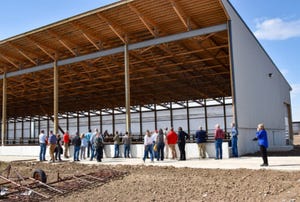Method reduces nutrient loads from recirculating aquaculture
Woodchip bioreactors found to be cost-effective solution for removing nitrogen from RAS water.
February 14, 2020

A joint project of the Technical University of Denmark (DTU), the Natural Resources Institute Finland (Luke) and the University of Jyväskylä has developed a cost-effective solution for the removal of nitrogen from recirculating aquaculture systems (RAS), according to an announcement from Luke.
The study aimed to identify nitrogen removal based on fish sludge and woodchip bioreactors. The joint project also studied innovative ways of reducing nutrient loads from RAS.
Recirculating aquaculture is a fish farming method in which water is circulated by pumping it from fish tanks into cleaning units and back, Luke explained. The method helps save water, and water cleaning technologies also help significantly reduce nutrient loads. By recovering solid matter, up to 80% of phosphorus can be recovered. However, no cost-effective methods have been available, especially for nitrogen removal in RAS.
According to the announcement, Luke and the University of Jyväskylä studied the use of woodchip bioreactors for removal of nitrate nitrogen. Woodchips act as a carbon source in a process in which nitrate nitrogen is converted into harmless nitrogen gas. In conventional denitrification -- a process in which nitrogen is released -- methanol, among other fuels, is used as an external carbon source. However, methanol is expensive, and its use involves a high occupational safety risk.
“The woodchip bioreactors proved a cost-effective solution. By modifying the size and delay of the bioreactor, we were able to remove 80% of nitrogen from recirculating aquaculture systems," Luke research scientist Jani Pulkkinen said. "Luke aims to study the operation of the woodchip bioreactor under winter conditions in test equipment in Laukaa [Finland] and to optimize the ratio between the bioreactor size and the volume or delay of water passing through it."
Phosphorus loads
In the project, Luke studied cost-effective means to reduce phosphorus and nitrogen loads in water discharged from RAS.
“By combining conventional sludge sedimentation with a modern woodchip bioreactor, we were able to remove 80% of phosphorus and as much as 97% of nitrogen. However, the large size of a woodchip bioreactor may limit the use of the technology in larger RAS,” Pulkkinen said.
The KTH Royal Institute of Technology in Sweden and Luke studied the removal of soluble phosphorus by means of reactive minerals. Polonite, a porous calcium silicate, was able to remove practically all soluble phosphorus from water discharged from RAS, Luke said.
Although Polonite was able to capture nearly all phosphorus from water, no full certainty of the method’s suitability in recirculating aquaculture was obtained, because it was impossible to test the saturation of Polonite, or the frequency at which it should be replaced, Luke added.
“The use of reactive minerals can prove an effective method to bind phosphorus and, therefore, to reduce a system’s phosphorus emissions to a fraction of their previous level,” Pulkkinen said.
You May Also Like



